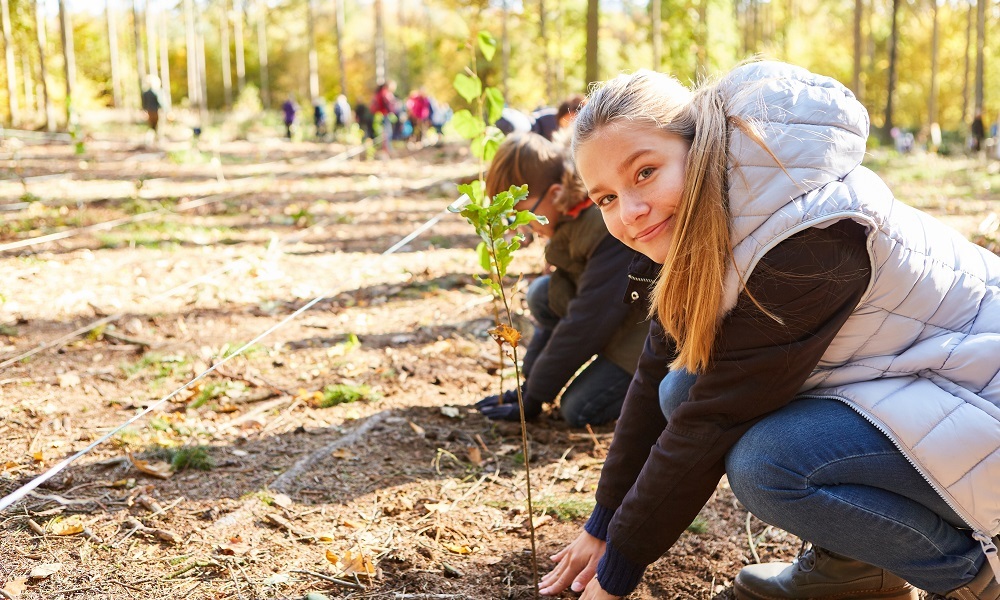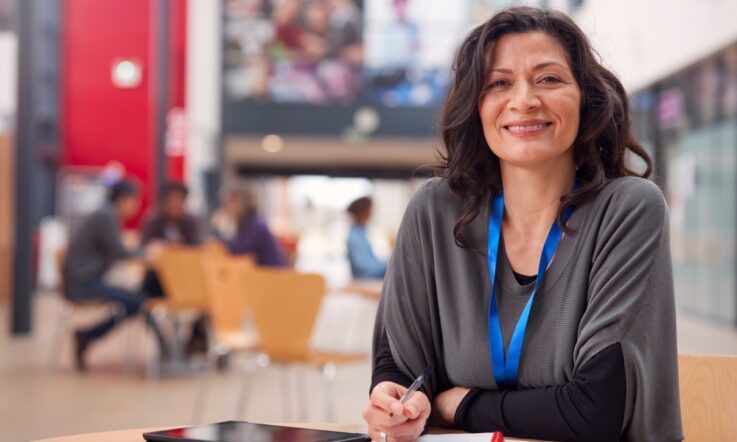Thanks for listening to this episode of Teacher Staffroom, where we catch you up on the latest evidence, insight, and action. I'm Rebecca Vukovic.
According to new data from the annual Mission Australia Youth Survey, the environment is now the number one concern for young people. In fact, of the 18,800 young people aged 15 to 19 who took part in the latest survey, 51% identified the environment as one of the most important issues in Australia compared to 38% in 2021 and 30% in 2020. The results show that 26% of young people were ‘extremely’ or ‘very concerned’ about climate change. In today’s episode of Teacher Staffroom, I’m going to run through some of the ways that schools are tackling issues of sustainability in their communities, both here in Australia and internationally. I’ll also highlight some contributions we featured on Teacher this month and bring you up to speed on what we’ve been working on here at the magazine. Let’s get started.
Right at the beginning of the month we published a piece celebrating the winners of this year’s Zayed Sustainability Prize, an annual competition that awards US $600,000 to global high schools with impactful, innovative, and inspiring sustainable solutions. Six high schools from across the world took home their share of the prize pool to continue their work. Make sure you check out the full article on our website, teachermagazine.com to read more about each of the winning schools.
Throughout this episode, I’ll be posing some questions for you to consider, or perhaps discuss with colleagues at your next team meeting. With your class or with colleagues, discuss the sustainability issues impacting your school and wider community. How could your school work together to address one, or some, of these issues? Are you aware of any local grants or funding that might be available to you to help bring these ideas to fruition?
Still on sustainability, my colleague Dominique Russell sat down with Venkata Kalva this month to record a podcast episode in our School Improvement series. Venkata is the Sustainability Coordinator at Brentwood Secondary College in Victoria and joins Dom to discuss their journey to prioritising sustainability in the school community, the function of the school’s Green Team, and advice for other schools across the country looking to prioritise sustainability in their school settings.
Here's Venkata talking about the sustainability initiatives taking place at the school.
To start with the first project that I undertook was introducing recycling bins in all our classrooms. And from there we went on to initiating several other projects. Over the past few years, Brentwood has not only focused on improving our infrastructure and reducing our waste, electricity, and water usage, but we've also worked on the 17 sustainable development goals.
We have reduced our impact on emissions by nearly 25% and also have saved the college nearly $900,000 in savings. And when it comes to what the school looks like now, everyone is aware of the Green Team. People know about the work that we do and people are willing to come on board to help us. And it's not only the practices that are seen at the college, but most of the staff and students also take such good practices home and they seem to be implementing those good practices at home and helping their family and friends as well.
Here are some questions to think about: Reflect on the work your school community is doing to be more sustainable. Can you identify some areas of improvement? How could you focus on one of these areas for the 2023 school year? Can you involve students, staff and the wider community?
Right at the beginning of the episode I mentioned the new findings to come from the Mission Australia Youth Survey. While the environment was the number one concern for young people, it was closely followed by equity and discrimination, and mental health as well.
More than one-third (in fact 35.9%) picked equity and discrimination as important nationally, and 27.1% said they’d been discriminated against in the past 12 months, mostly on the basis of their gender, race/cultural background or mental health.
As in previous years, mental health was a major concern for young people – 34% felt it was an important national issue, while 29% indicated [high] psychological distress and 23.5% said they felt lonely all or most of the time. More than half of those surveyed (53.4%) said they had needed support with their mental health at some point in their lives.
After you read the article on Teacher, here are some questions to reflect on. What are the personal challenges facing your students before they even make it to school? As a school leader, what support systems do you have in place to help students navigate the challenges mentioned in the 2022 report?
Moving on from sustainability now, I’d like to share with you some of the valuable contributions we’ve published on Teacher this month.
We marked Safer Internet Day in early February with a special contribution from Australia’s eSafety Commissioner, Julie Inman Grant. In her article, Julie shares how eSafety has spent the last 7 years working to achieve better prevention, protection and proactive change outcomes for Australians. She also shares details of an open letter written by eSafety’s Online Safety Youth Council that calls on Big Tech to take action against those who abuse or harass others online. Here is a quote from Julie in the article:
…Research by eSafety tells us that 45% of Australian children said they were treated in a hurtful or nasty way online in the past year; 33% said they felt left out or lost friends; and 20% per cent said they felt helpless or powerless.
These are just some of the raw facts and figures. We know that behind such numbers are real people suffering real pain, with sometimes tragic consequences – and all at a time when we are rushing headlong into a metaverse that will only exacerbate current challenges and potentially create new ones.
Consider for a moment the virtual reality headsets that immerse children in 360-degree worlds where they swim with sharks and mermaids. Or technology that transports them to the sights, sounds and sensations of ancient Rome. Or multi-player gaming where they can touch – or be touched – by their opponents.
This isn’t future tech, it’s today’s tech. For better or worse, these immersive technologies already allow us to interact with digital content in ways that look, sound, and feel similar to real life. Are we ready for such hyper-realistic experiences? More importantly, are our children ready?
This month we also published a really interesting Q&A with Dr Amy Berry, a Research Fellow at the Australian Council for Educational Research (ACER) and an honorary fellow at the University of Melbourne. Her new book Reimagining Student Engagement: From Disrupting to Driving proposes an engagement model positioning students as active partners in the learning process and explores how to encourage learners to participate, invest, and drive their own learning experiences. In the Q&A, Amy explores the challenges teachers face when engaging students in the classroom, the impact this has on students’ wellbeing and sense of belonging, and how teachers can cultivate a culture of engagement in their classrooms.
Here’s a quote from Amy from the article where she’s discussing how she defines student engagement.
Student engagement has become a big umbrella term that means everything from turning up to school to becoming completely immersed in trying to understand something better or master something. Often, we make very little distinction between being engaged in school – turning up and taking part in things that happen at school – and being engaged in the process of learning – taking actions designed to improve our understanding or skills. These 2 things are related but they are not the same thing.
This has led to some understandable confusion about what it is that we are talking about when we say we want to improve student engagement. My work focuses specifically on student engagement in learning; the degree of effort, interest, curiosity, persistence and risk-taking that students choose to invest in learning.
Here’s something to think about. How do you define student engagement in your classroom? What does engagement look like and how will you know if you’ve succeeded in improving it? Are these goals shared with students?
The final contribution I wanted to highlight today is a video contribution we published from English and English Language teacher, Steven Kolber. In the video, he shares how teachers can encourage their students to learn with dance as a physical memorisation technique, to assist with the memorisation of important concepts.
He also says physical memorisation strategies can be a simple and effective strategy for helping students to memorise concepts by coming up with physical manifestations and representations of these concepts. In the video, he shares an example of how you can teach students to make up a dance.
This is really useful because, as we know, in an examination … you can’t bring books, you can’t bring notes … but they’ll always have their body. They’ll always have their arms, their legs, their limbs, and ideally, also their memory of these series of actions they’ve used to memorise this concept or a series of concepts that you’ve taught them.
After watching the video on our YouTube channel, consider these questions. What strategies are you planning to employ to help students memorise for an assessment? Have these strategies worked effectively in the past? What impact do you think physical memory techniques might have?
Finally, I also wanted to let you know about an exciting new resource we’ve been working on and can finally share with you -Teacher Jobs. It’s now live at jobs.teachermagazine.com Whether you’re looking to find your next job opportunity or to hire somebody in this competitive recruitment market, Teacher Jobs allows you to cast your net wider than ever before. Be sure to check out the website to learn more about the packages we have available or to search through the jobs already listed.
That's all for this episode, and you’re now all caught up on the latest evidence, insight and action. Links to all the content and the resources I’ve mentioned will be in the transcript of this podcast available over at our website, teachermagazine.com.
Subscribe to our podcast channel wherever you get your podcasts from, so you can be notified of any new episodes as soon as they land. If you want to keep listening now, you can access the 200+ episodes already in our archive. And, while you’re there, we’d love if you could rate and review us.



